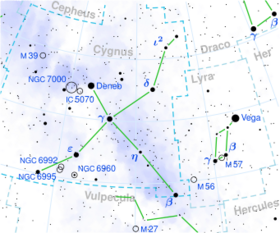Astronomy:Sigma Cygni
| Observation data Equinox J2000.0]] (ICRS) | |
|---|---|
| Constellation | Cygnus |
| Right ascension | 21h 17m 24.95244s[1] |
| Declination | +39° 23′ 40.8528″[1] |
| Apparent magnitude (V) | 4.233[2] |
| Characteristics | |
| Spectral type | B9 Iab[2] |
| U−B color index | −0.386[2] |
| B−V color index | +0.123[2] |
| Astrometry | |
| Radial velocity (Rv) | −5.30 ± 0.40[3] km/s |
| Proper motion (μ) | RA: −0.13[1] mas/yr Dec.: −3.58[1] mas/yr |
| Parallax (π) | 1.13 ± 0.19[1] mas |
| Distance | 1,000[4] pc |
| Absolute magnitude (MV) | −6.18[4] |
| Details | |
| Mass | 15[5] M☉ |
| Radius | 54[4] R☉ |
| Luminosity | 52,500[6] L☉ |
| Surface gravity (log g) | 1.85[2] cgs |
| Temperature | 10,800[2] K |
| Metallicity | 0.0[6] |
| Rotational velocity (v sin i) | 14[2] km/s |
| Age | 16[6] Myr |
| Other designations | |
| Database references | |
| SIMBAD | data |
Sigma Cygni, Latinised from σ Cygni, is a blue supergiant star in the constellation Cygnus. Its apparent magnitude is 4.2. It belongs to the Cygnus OB4 stellar association and is located approximately 3,300 light years away from Earth.
Because of its location in the galactic disk, σ Cyg is obstructed by interstellar dust and is reddened by around 0.2 magnitudes and loses about 0.6 magnitudes at visual wavelengths.[2] Allowing for this, the star is over 50,000 times as luminous as the sun.
Spectral analysis of the star showed that photospheric SiII and HeI lines display a simultaneous, periodic variability. The periodicity was calculated at 1.59 hours in all three lines and it might be the result of stellar oscillations.[7] No clear variation in the brightness has been detected.[8]
The elemental composition of Sigma Cygni is unusual. The star is enriched in helium, and has extremely high concentrations of nitrogen, calcium, cerium and europium, while carbon and aluminum are depleted relative to the Sun.[6]
References
- ↑ 1.0 1.1 1.2 1.3 1.4 Van Leeuwen, F. (2007). "Validation of the new Hipparcos reduction". Astronomy and Astrophysics 474 (2): 653–664. doi:10.1051/0004-6361:20078357. Bibcode: 2007A&A...474..653V.
- ↑ 2.0 2.1 2.2 2.3 2.4 2.5 2.6 2.7 Firnstein, M.; Przybilla, N. (2012). "Quantitative spectroscopy of Galactic BA-type supergiants. I. Atmospheric parameters". Astronomy & Astrophysics 543: A80. doi:10.1051/0004-6361/201219034. Bibcode: 2012A&A...543A..80F.
- ↑ Gontcharov, G. A. (2006). "Pulkovo Compilation of Radial Velocities for 35 495 Hipparcos stars in a common system". Astronomy Letters 32 (11): 759–771. doi:10.1134/S1063773706110065. Bibcode: 2006AstL...32..759G.
- ↑ 4.0 4.1 4.2 Markova, N.; Puls, J. (2008). "Bright OB stars in the Galaxy. IV. Stellar and wind parameters of early to late B supergiants". Astronomy and Astrophysics 478 (3): 823. doi:10.1051/0004-6361:20077919. Bibcode: 2008A&A...478..823M.
- ↑ Przybilla, N.; Firnstein, M.; Nieva, M. F.; Meynet, G.; Maeder, A. (2010). "Mixing of CNO-cycled matter in massive stars". Astronomy and Astrophysics 517: A38. doi:10.1051/0004-6361/201014164. Bibcode: 2010A&A...517A..38P.
- ↑ 6.0 6.1 6.2 6.3 Tanrıverdi, Taner (2013). "Elemental abundances of the supergiant stars σ Cygnus and η Leonis". New Astronomy 25: 50. doi:10.1016/j.newast.2013.03.013. Bibcode: 2013NewA...25...50T.
- ↑ Kraus, M.; Tomić, S.; Oksala, M. E.; Smole, M. (June 2012). "Detection of a 1.59 h period in the B supergiant star HD 202850". Astronomy and Astrophysics 542: L32. doi:10.1051/0004-6361/201219319. Bibcode: 2012A&A...542L..32K.
- ↑ Koen, Chris; Eyer, Laurent (2002). "New periodic variables from the Hipparcos epoch photometry". Monthly Notices of the Royal Astronomical Society 331 (1): 45–59. doi:10.1046/j.1365-8711.2002.05150.x. Bibcode: 2002MNRAS.331...45K.
 |


